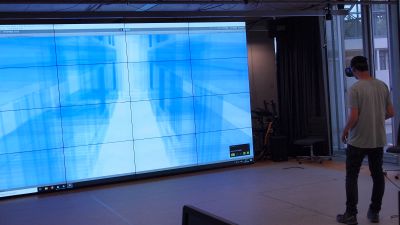No edit summary |
No edit summary |
||
| Line 15: | Line 15: | ||
Figure 1 | Figure 1 | ||
The stages of VR space are divided into three levels: Weltraum, and Governance, and these stages each express themselves through the process of ontological resemblance to these three images: tilted floor, and ship. Unlike the partial collision or overlapping of the three media (reality, VR and sculpture) these three stages flow as temporal environments embracing the audience, and passing over time, the story of each stage switches to the next one, as if the Act 2 of the show comes after Act 1. As if winter appears after spring, summer and autumn. | The stages of VR space are divided into three levels: Weltraum, and Governance, and these stages each express themselves through the process of ontological resemblance to these three images: tilted floor, and ship. Unlike the partial collision or overlapping of the three media (reality, VR and sculpture) these three stages flow as temporal environments embracing the audience, and passing over time, the story of each stage switches to the next one, as if the Act 2 of the show comes after Act 1. As if winter appears after spring, summer and autumn. | ||
Revision as of 20:13, 30 September 2019
The Weired - 2019
VR Experiment: Dear My Tilted Floor (tentative title) [1] https://www.youtube.com/watch?v=TKeeA2Ul53U
Three Stages of VR Places
Figure 1
The stages of VR space are divided into three levels: Weltraum, and Governance, and these stages each express themselves through the process of ontological resemblance to these three images: tilted floor, and ship. Unlike the partial collision or overlapping of the three media (reality, VR and sculpture) these three stages flow as temporal environments embracing the audience, and passing over time, the story of each stage switches to the next one, as if the Act 2 of the show comes after Act 1. As if winter appears after spring, summer and autumn.
When a spectator enters the very first place of VR, an abstracted representation of the real space, a female voice suddenly recites a part of a poem about love and absence. The representation of the place is not exactly the same but has the same scale of the place and is given precisely the same localization of body of both real and virtual spaces in the euclidean coordinate system. During the recitation, the spectator focuses on the meaning of the poem and at the same time roams around the abstracted representation of the place, the ocular sensation and tactile perception slowly collide with each other by the tilting of the virtually, electronically generated floor and stationary aspect of floor in the real place, which are sharing the sense of gravity. The subject of the remaining audio-visual sensation, then, is soaked into the transitional space and the next public place, which contains the collective trauma of the Korean people in 2014.
The second scene starts off with the metaphoric images of ship and water. This scene illustrates what should have been done whenever the control and communication system in a social organism is broken. During the Sewol Ferry tragedy which took more than 300 lives, only the very few people who trusted their natural instinct had a chance to survive the disaster. Yet, those who followed the instruction of the irresponsible crew, sadly, could not survive from this cold ironic frame. Inside the bedroom of the ship, the only trace of the existential human beings are some voices. The user’s point of view is embedded into an object on a small cupboard next to the window [Figure 1]. Sound of passengers fill the place, yet, soon, the announcement of the captain echoes again and again. “According to the instruction of our crew, please, all passengers come up to the deck. This is an emergency situation.” Voice of angry high school boy against the unbelievable situation and urgent footsteps of other people fill the whole space, then the floor begins to tilt. The horizon of the sea rises and reaches the top of the window. Slowly, the whole soundscape decreases and the place is soaked in the white space, which means nothing but whole.
After this whole journey, the user comes back to the very first place, where reflects the real place, and receives instruction for the alienation effect, which indicates it is not a real world and instructs how to get out of this world of VR.
REFERENCES
Dünne, J. at el (2006). Raumtheorie: Grundlagentexte aus Philosophie und Kulturwissenschaften. Suhrkamp Verlag, pp. 321
Pallasmaa, J. (2012). “Spaces of Memory and Imagination”, The Eyes of the Skin. Wiley; 3 edition (May 14, 2012), pp. 73-74
PICTURE CREDITS
Figure 1. Photo: Daniel Kempton
